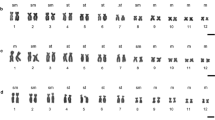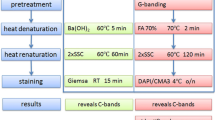Abstract
A C-banding and silver staining analysis of 12 species of Australian frogs of the genus Litoria, has shown that 6 morphologically distinct classes of secondary constrictions are present. These constrictions are distinguished by the distribution and type of C-banding chromatin and the distribution of silver staining material. Not all of these constrictions are nucleolus organizers. Groups of closely related species often share particular constrictions, although previously unencountered constrictions do occur in some species. It is argued that changes in position of nucleolar organizing constrictions is most easily explained by the amplification of latent nucleolus organizing sites. One of the more unusual features of this group of species is the shared similarity in gross chromosome morphology, contrasted to the extensive C-banding variation at secondary constriction sites. While in some of these cases chromosomal evolution has undoubtedly proceeded by the addition of heterochromatic segments, the predominant mechanism of change appears to involve the large scale transformation of euchromatin to heterochromatin.
Similar content being viewed by others
References
Barker, J., Grigg, G.: A field guide to Australian frogs. Rigby: Australia Ltd (1977)
Bianchi, N.O., Bianchi, M.S., Vidal-Rioja, L.: Heterochromatin later replication and secondary constrictions in the chromosome complement of Leptodactylus ocellatus. Caryologia (Firenze) 26, 397–403 (1973)
Bicudo, H.E.M.C., Richardson, R.H.: Gene regulation in Drosophila mulleri, Drosophila arizonensis and their hybrids: the nucleolar organizer. Proc. nat. Acad. Sci. (Wash.) 74, 3498–3502 (1977)
Bogart, J.P.: Karyotypes. In: Evolution in the genus Bufo. Austin: W.F. Blair (ed.). University of Texas Press 1972
Bogart, J.P.: Evolution of anuran karyotypes. In: Evolutionary biology of the anurans. (J.L. Vial, ed.) University of Missouri Press 1973
De Weese,J.: Chromosomes in Eleutherodaytylus (Anura, Leptodactylidae). Mammal. Chrom. Newsletter 16, 121–123 (1975)
Goodpasture, C., Bloom, S.E.: Visualization of nucleolar organizer regions in mammalian chromosomes using silver staining. Chromosoma (Berl.) 53, 37–50 (1975)
Gropp, A., Winking, H., Zech, L., Müller, H.: Robertsonian Chromosomal variation and identification of metacentric chromosomes in feral mice. Chromosoma (Berl.) 39, 265–288 (1972)
Heppich, S.: Hybridogenesis in Rana esculenta: C-band karyotypes of Rana ribibunda, Rana lessonae and Rana esculenta. Z. Zool. Syst. Evolutionsforsch. 16, 27–39 (1978)
Hutchinson, N., Pardue, M.L.: The mitotic chromosomes of Notophthalmus (=triturus) viridescens: localization of C banding regions and DNA sequences complementary to 18 S, 28 S and 5 S ribosomal RNA. Chromosoma (Berl.) 53, 51–69 (1975)
John, B., King, M.: Heterochromatin variation in Cryptobothrus chrysophorus. 1. Chromosome differentiation in natural populations. Chromosoma (Berl.) 64, 219–239 (1977)
King, M.: The evolution of sex chromosomes in lizards. In: Evolution and reproduction. Proc. 4th Int. Conf. on Reproduction and Evolution, pp. 55–60. Aust. Acad. Sci. 1977
King, M., John, B.: Regularities and restrictions governing C-band variation in Acridoid grasshoppers. Chromosoma (Berl.) 76, 123–150 (1980)
King, M., King, D.: Chromosomal evolution in the lizard genus varanus (Reptilia). Aust. J. Biol. Sci. 28, 89–108 (1975)
King, M., Rofe, R.: Karyotypic variation in the Australian gekko Phyllodactylus marmoratus (Gray) (Gekkomdae: Reptilia). Chromosoma (Berl.) 54, 75–87 (1976)
King, M., Tyler, M.J., Davies, M., King, D.: Karyotypic studies on Cyclorana and associated genera of Australian frogs. Aust. J. Zool. 27, 373–393 (1979)
Macgregor, H.C., Kezer, J.: The nucleolar organizer of Plethodon C. cinereus (Green). 1. Location of the nucleolar organizer by in situ nucleic acid hybridization. Chromosoma (Berl.) 42, 415–426 (1973)
Macgregor, H.C., Mizuno, S.: In situ hybridization of “Nick translated” 3H-ribosomal DNA to chromosomes from salamanders. Chromosoma (Berl.) 54, 15–25 (1976)
Macgregor, H.C., Vlad, M., Barnett, E.: An investigation of some problems concerning nucleolus organizers in Salamanders. Chromosoma (Berl.) 59, 283–299 (1977)
Menzies, J.I., Tippet, J.: Chromosome numbers of Papuan Hylid frogs and the Karyotype of Litoria infrafrenata (Amphibia Anura, Hylidae). J. Herpetol. 10, 167–173 (1976)
Morescalchi, A.: Amphibia. In: Cytotaxonomy and vertebrate evolution. (A.B. Chiarelli and E. Capanna, eds.). pp. 233–348. New York and London: Academic Press 1973
Nardi, I., Barsacci-Pilone. G., Batistoni, R., Andronico, F.: Chromosome location of the ribosomal RNA genes in Triturus vulgaris meridionalis (Amphibia, Urodela). 11. Intraspecific variability in number and position of the chromosome loci for 18 S and 28 S ribosomal RNA. Chromosoma (Berl.) 64, 67–84 (1977)
Rothfels, K., Freeman, M.: The salivary gland chromosomes of three North American species of Tarinnia (Diptera: Simuliidae). Canad. J. Zool. 44, 937–945 (1966)
Rudak, E., Callan, H.G.: Differential staining and chromatin packing of the mitotic chromosomes of the newt Triturus cristatus. Chromosoma (Berl.) 56, 349–362 (1976)
Schmid, M.: Chromosome banding in Amphibia. 1. Constitutive heterochromatin and nucleolus organizer regions in Bufo and Hyla. Chromosoma (Berl.) 66, 361–388 (1978a)
Schmid, M.: Chromosome banding in Amphibia. 11. Constitutive heterochromatin and nucleolus organizer regions in Ranidae, Microhylidae, Rhacophoridae. Chromosoma (Berl.) 68, 131–148 (1978b)
Shaw, D.D.: The supernumerary segment system of Stethophyma. 1. Structural basis. Chromosoma (Berl.) 30, 326–343 (1970)
Singh, L., Purdom, I.F., Jones, K.W.: Satellite DNA and the evolution of sex chromosomes. Chromosoma (Berl.) 59, 43–62 (1976)
Stephenson, E.M., Stephenson, N.G.: Karyotypes of two Australian hylids. Chromosoma (Berl.) 30, 38–50 (1970)
Tyler, M.J., Davies, M.: Species groups within the Australopapuan hylid frog genus Litoria tschudi. Aust. J. Zool., Suppl. series, 63 (1978)
Varley, J.M., Morgan, G.T.: Silver staining of the lampbrush chromosomes of Triturus cristatus carnifex. Chromosoma (Berl.) 67, 233–244 (1978)
Ward, O.G.: Dimorphic nucleolar organizer regions in the frog Rana blairi. Canad. J. Cytol. 19, 51–57 (1977)
White, M.J.D.: Animal cytology and evolution, 3rd edit. London: Cambridge University Press 1973
White, M.J.D.: Chromosome repatterning: regularities and restrictions. Genetics 79, 63–72 (1975)
Wilson, A.C., Sarich, V.M., Maxson, L.R.: The importance of gene rearrangement in evolution: evidence from studies on rates of chromosomal, protein, and anatomical evolution. Proc. nat. Acad. Sci. (Wash.) 71, 3028–3030 (1974)
Author information
Authors and Affiliations
Rights and permissions
About this article
Cite this article
King, M. C-Banding studies on australian hylid frogs: secondary constriction structure and the concept of euchromatin transformation. Chromosoma 80, 191–217 (1980). https://doi.org/10.1007/BF00286300
Received:
Accepted:
Issue Date:
DOI: https://doi.org/10.1007/BF00286300




